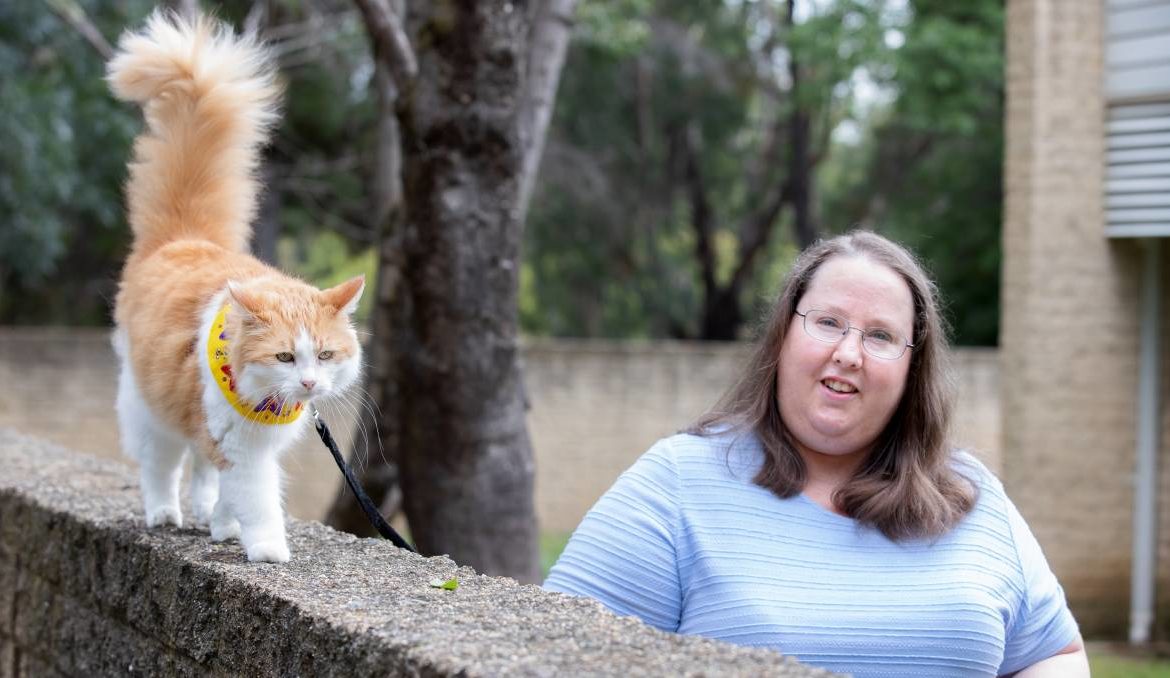news, latest-news,
The ACT government is considering options to extend cat containment across Canberra, including the possibility of locking up all cats across the national capital. It is also promising to review existing laws and clarify whether or not cat owners in suburbs already declared cat containment areas can exercise their cat outside on a leash. That assurance from City Services Minister Chris Steel on Friday came after a campaign by Wright resident Emerson Riley who has started a change.org petition seeking a change to the Domestic Animals Act 2000 to allow cats to be walked on a leash in Canberra’s containment suburbs. Close to 1500 people had signed Ms Riley’s petition by Friday afternoon. Mr Steel also confirmed the government was considering the issue of extending cat containment. The government has already declared 17 new suburbs in Canberra cat containment areas in an effort to protect native wildlife. It also maintains the strategy protects cats from being injured. Other new suburbs in Gungahlin and the Molonglo Valley are likely to be declared in the future, according to the directorate. Residents within cat containment areas are required to keep their cats confined to their premises at all times or else risk a $1500 fine. The Draft ACT Cat Plan 2019-29 says about a quarter of Canberra households own cats. The draft plan says cat containment is “a key policy for reducing the impact of cats on the environment”. The government’s “initial preferred approach” is to gradually extend cat containment areas to certain established or new suburbs close to wildlife areas, according to the report. But the draft plan also considers a grandfathered approach where all cats acquired after a certain date would have to be contained throughout the ACT. Cats owned before that date would not have to be contained (unless they live in an existing cat containment area). The third option being considered by the government is a blanket approach with all established suburbs declared as cat containment areas at a set future date, with a transition period of “say 5, 10, or 20 years”. “While the blanket approach of Option C would be simpler to administer and give all residents the same transition period, the Government recognises this could negatively affect cats use [d] to being outside, and have flow on issues for their households,” the report says. Mr Steel said on Friday “the issue of cat containment is currently being considered by the ACT Government including community comments on the draft Cat Plan”. “Any potential changes to relevant legislation will be made in the interests of animal welfare and environmental protection grounds,” he said. Ms Emerson moved to Wright last year knowing it was a cat containment suburb but had been told by Domestic Animal Services she could walk her cat Mimi on a lead because she was “contained”. That advice from DAS later changed to the cat needed to stay inside or else Ms Riley would be fined $1500. Ms Riley said Mimi, nearly 10, had loved going on walks on a lead. She said cats in containment areas deserved that mental and physical stimulation of being outside on a lead “sniffing and eating grass and rolling in the dirt”. “Being outside makes her really happy. It stimulates and enriches her. It’s not necessarily about the walking, it’s about the sights and the sounds and the smells,” she said. Ms Riley agreed that cats were predators and that was why she kept her cat on a lead, even when she lived before in Phillip, which was not a cat containment area. “We’re animal lovers, we’re not just cat lovers,” she said. “I don’t want her ever to be hurting wildlife. I love birds and lizards. I grew up in the bush. There’s no way I would ever want her hurting an animal.” Ms Riley believed the government’s agenda was to lock up all cats and if that was the case, they had to come up with options to allow them outside in some capacity. “It’s going to be disastrous otherwise, the behaviour problems. I think this is the solution to allow them out on a harness or leash,” she said. Mr Steel on Friday acknowledged there was confusion around the issue. “The current wording of the Domestic Animals Act may be interpreted that cats cannot be walked on a lead in containment suburbs, which was not the intention,” her said. “We are considering changes to the Domestic Animals Act to clarify this issue later in the year following the finalisation of the Cat Plan. During this interim period, DAS rangers will be taking an educative approach on this issue.” The ACT Government would “consider amendments to the Act to clarify that cats may be walked on a lead and harness in all suburbs, including containment suburbs”. “Cats currently can be walked on a lead or harness in non-cat containment suburbs,” Mr Steel said. Ms Riley said she would continue with the petition until the laws were changed despite the minister’s assurances. “It does give me hope but I want to make them accountable and make sure they do it,” she said. The other issue for residents in containment areas was keeping in their cats. Ms Riley said she needed to spend $3000 to put up mesh barriers in her apartment courtyard, but that plan had not yet been given the green light by her body corporate. The ACT suburbs already declared cat containment areas are Bonner, Crace, Coombs, Denman Prospect, Forde, Gungahlin Town Centre east, Jacka, Lawson, Macnamara, Molonglo, Moncrieff, Strathnair, The Fair at Watson, Throsby, Taylor, Whitlam and Wright.
/images/transform/v1/crop/frm/32suSVsqH3pdw6NJyh92X9D/2a7a1dd3-b01a-45f9-ac52-b3f95e66ab40.jpg/r0_246_5500_3354_w1200_h678_fmax.jpg
The ACT government is considering options to extend cat containment across Canberra, including the possibility of locking up all cats across the national capital.
It is also promising to review existing laws and clarify whether or not cat owners in suburbs already declared cat containment areas can exercise their cat outside on a leash.
That assurance from City Services Minister Chris Steel on Friday came after a campaign by Wright resident Emerson Riley who has started a change.org petition seeking a change to the Domestic Animals Act 2000 to allow cats to be walked on a leash in Canberra’s containment suburbs. Close to 1500 people had signed Ms Riley’s petition by Friday afternoon.
Mimi the cat out for a walk in Phillip, which is not a cat containment area. Picture: Supplied
Mr Steel also confirmed the government was considering the issue of extending cat containment.
The government has already declared 17 new suburbs in Canberra cat containment areas in an effort to protect native wildlife. It also maintains the strategy protects cats from being injured.
Other new suburbs in Gungahlin and the Molonglo Valley are likely to be declared in the future, according to the directorate.
Residents within cat containment areas are required to keep their cats confined to their premises at all times or else risk a $1500 fine.
The Draft ACT Cat Plan 2019-29 says about a quarter of Canberra households own cats.
The draft plan says cat containment is “a key policy for reducing the impact of cats on the environment”.
The government’s “initial preferred approach” is to gradually extend cat containment areas to certain established or new suburbs close to wildlife areas, according to the report.
But the draft plan also considers a grandfathered approach where all cats acquired after a certain date would have to be contained throughout the ACT. Cats owned before that date would not have to be contained (unless they live in an existing cat containment area).
The third option being considered by the government is a blanket approach with all established suburbs declared as cat containment areas at a set future date, with a transition period of “say 5, 10, or 20 years”.
“While the blanket approach of Option C would be simpler to administer and give all residents the same transition period, the Government recognises this could negatively affect cats use [d] to being outside, and have flow on issues for their households,” the report says.
Mr Steel said on Friday “the issue of cat containment is currently being considered by the ACT Government including community comments on the draft Cat Plan”.
“Any potential changes to relevant legislation will be made in the interests of animal welfare and environmental protection grounds,” he said.
Ms Emerson moved to Wright last year knowing it was a cat containment suburb but had been told by Domestic Animal Services she could walk her cat Mimi on a lead because she was “contained”. That advice from DAS later changed to the cat needed to stay inside or else Ms Riley would be fined $1500.
Ms Riley said Mimi, nearly 10, had loved going on walks on a lead. She said cats in containment areas deserved that mental and physical stimulation of being outside on a lead “sniffing and eating grass and rolling in the dirt”.
Emerson Riley now takes her cat to work in Deakin three times a week for a walk. Picture: Sitthixay Ditthavong
“Being outside makes her really happy. It stimulates and enriches her. It’s not necessarily about the walking, it’s about the sights and the sounds and the smells,” she said.
Ms Riley agreed that cats were predators and that was why she kept her cat on a lead, even when she lived before in Phillip, which was not a cat containment area.
“We’re animal lovers, we’re not just cat lovers,” she said. “I don’t want her ever to be hurting wildlife. I love birds and lizards. I grew up in the bush. There’s no way I would ever want her hurting an animal.”
Ms Riley believed the government’s agenda was to lock up all cats and if that was the case, they had to come up with options to allow them outside in some capacity.
“It’s going to be disastrous otherwise, the behaviour problems. I think this is the solution to allow them out on a harness or leash,” she said.
Mr Steel on Friday acknowledged there was confusion around the issue.
“The current wording of the Domestic Animals Act may be interpreted that cats cannot be walked on a lead in containment suburbs, which was not the intention,” her said.
“We are considering changes to the Domestic Animals Actto clarify this issue later in the year following the finalisation of the Cat Plan. During this interim period, DAS rangers will be taking an educative approach on this issue.”
The ACT Government would “consider amendments to the Act to clarify that cats may be walked on a lead and harness in all suburbs, including containment suburbs”.
“Cats currently can be walked on a lead or harness in non-cat containment suburbs,” Mr Steel said.
Ms Riley said she would continue with the petition until the laws were changed despite the minister’s assurances.
“It does give me hope but I want to make them accountable and make sure they do it,” she said.
The other issue for residents in containment areas was keeping in their cats. Ms Riley said she needed to spend $3000 to put up mesh barriers in her apartment courtyard, but that plan had not yet been given the green light by her body corporate.
The ACT suburbs already declared cat containment areas are Bonner, Crace, Coombs, Denman Prospect, Forde, Gungahlin Town Centre east, Jacka, Lawson, Macnamara, Molonglo, Moncrieff, Strathnair, The Fair at Watson, Throsby, Taylor, Whitlam and Wright.







